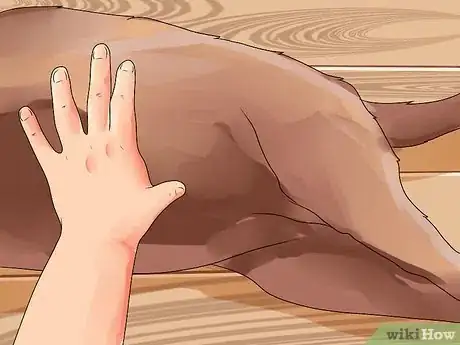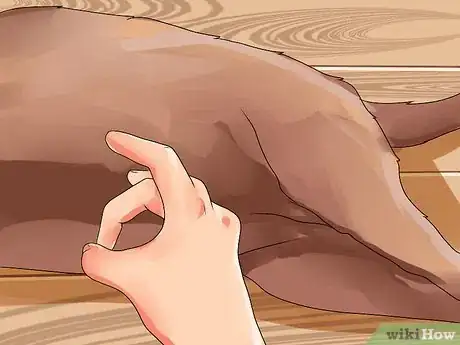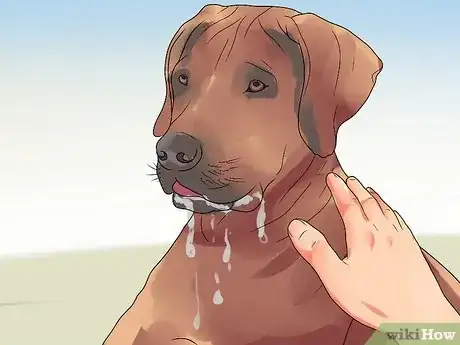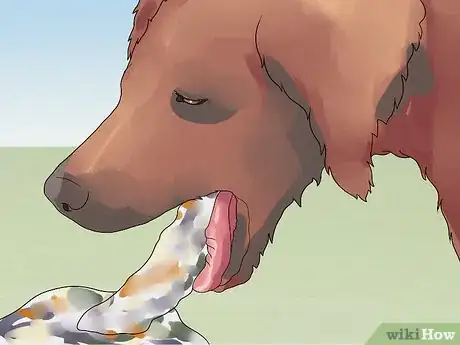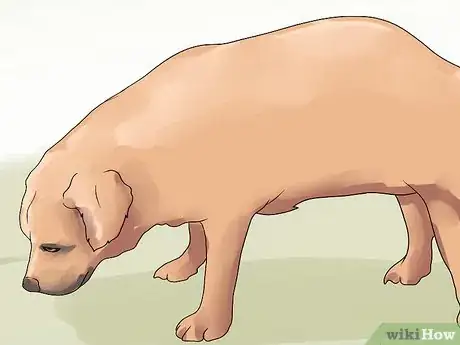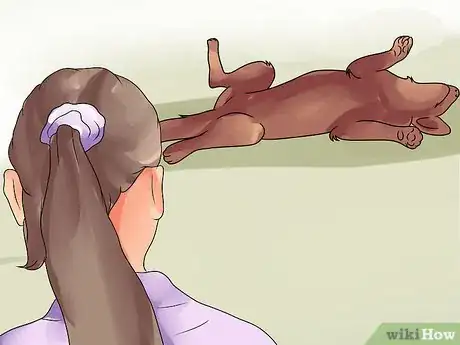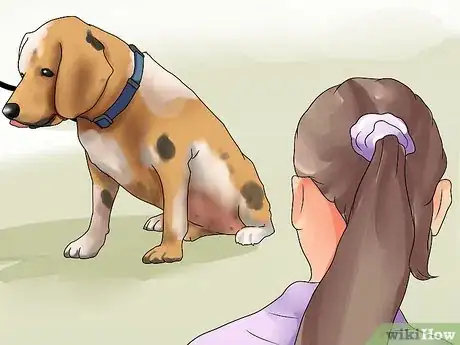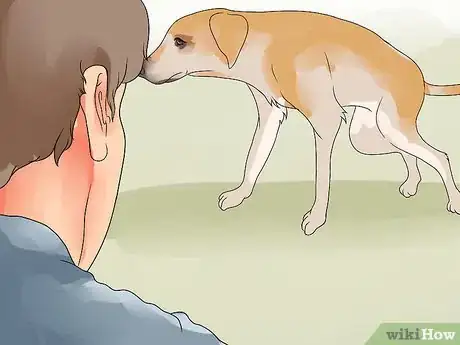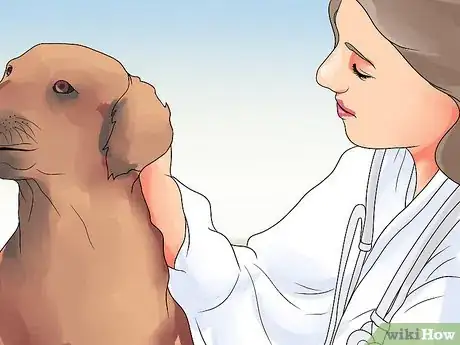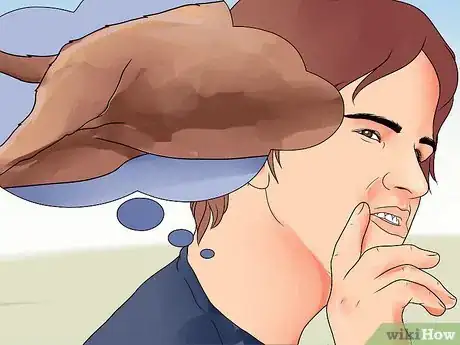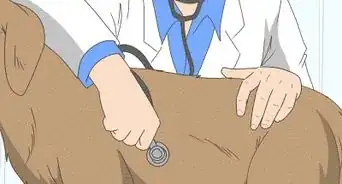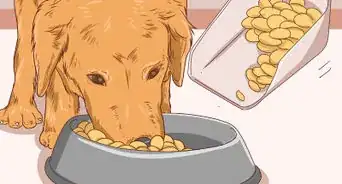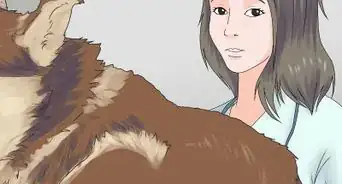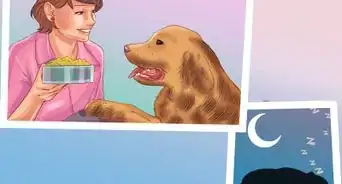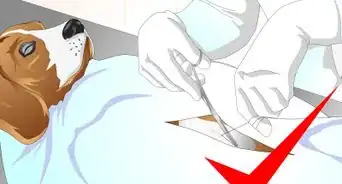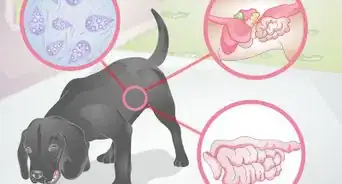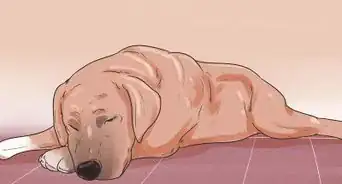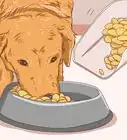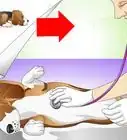This article was co-authored by Ray Spragley, DVM. Dr. Ray Spragley is a Doctor of Veterinary Medicine and the Owner/Founder of Zen Dog Veterinary Care PLLC in New York. With experience in multiple institutions and private practices, Dr. Spragley’s specializations and interests include non-surgical management of cranial cruciate ligament tears, Intervertebral Disk Disease(IVDD), and pain management in osteoarthritis. Dr. Spragley holds a BS in Biology from SUNY Albany and has a Doctor of Veterinary Medicine degree (DVM) from Ross University School of Veterinary Medicine. He is also a Certified Canine Rehabilitation Therapist (CCRT) through the Canine Rehab Institute as well as a Certified Veterinary Acupuncturist (CVA) through Chi University.
This article has been viewed 94,674 times.
Bloat is a serious, life-threatening condition. If your dog develops bloat, the sooner you seek urgent veterinary attention, the better his chances of recovery. If you are the least bit suspicious that your dog is developing symptoms of bloat, stay calm, phone your vet immediately, and bring your dog in as soon as possible.
Steps
Recognizing Symptoms of Bloat
-
1Call your vet if your dog’s stomach looks swollen. Dog's with bloat deteriorate alarmingly quickly. A dog that develops bloat at bedtime, if left untreated, will most likely pass away by the morning. Sometimes the deterioration is even more rapid, and the dog may pass away in less than 2 hours after first developing symptoms. Because of this, it is absolutely imperative that you call your vet immediately, as soon as you notice the following symptoms.[1] [2]
- The key symptoms are a distended abdomen and non-productive retching (vomiting without producing any vomit). These signs alone should trigger an emergency phone call to the vet. However, other signs can also occur, as discussed in the following steps.
-
2Look for a swollen abdomen. The abdomen (or belly) is the area behind the rib cage that extends back towards the pelvis. The stomach sits within the dome of the diaphragm, but if filled with air, it extends backwards into the belly. A gas filled stomach gives the physical appearance of a swollen belly.[3] [4]
- In some large breeds (St Bernards, Great Danes) the swollen stomach can be difficult to spot because of room for expansion within the dome of the ribs, therefore, an absence of swelling does NOT rule out gastric dilation. However, a swollen tummy is a significant sign.
- If in doubt as to whether the tummy is a normal size or not, take a photo of the dog from a sideways angle. Take another photo at 10 minute intervals for comparison. If subsequent photos show the body walls bowing outwards more than previously, this is significant and you should immediately contact the vet
Advertisement -
3Check for a tympanic abdomen. The swollen stomach is often full of gas or foam. When you place a hand on either side of the swelling and press gently, the area feels hard and not compressible.[5]
- If you gently flick at the swollen area with a finger (like flicking a drum skin) you may get the impression of a drum like noise due to the trapped air inside the stretched stomach.
-
4Monitor any drooling saliva. When the stomach flips over it is effectively sealed off. Gastric contents cannot escape; this also means that saliva, food, and water cannot get into the stomach.[6] Thus your dog may drool saliva because he cannot swallow it down.
-
5Keep track of non-productive retching or vomiting. The distension triggers receptors in the stomach wall that tells your dog to vomit in order to empty his stomach. However, the twisted stomach is sealed off and although the dog retches or attempts to vomit, he brings nothing up other than drooled saliva.
- This is a serious sign and if present, contact the vet immediately.
-
6Look to see if your dog has a hunched back. As the stomach swells it presses forward on the diaphragm and displaces other abdominal organs backwards. This causes abdominal discomfort which may cause the dog to stand in a hunched position with his back arched.
- This is a general sign of abdominal discomfort, rather than specific to GDV, but if seen in conjunction with other symptoms, it should raise concern.
-
7Watch to see if your dog appears restless. A dog with a dilated stomach feels uncomfortable and nauseous. This makes it difficult for him to get comfortable and he will pace and be restless.
- Some dogs repeatedly turn and look at their flanks, whilst others may even try to kick their belly with a back leg.
-
8Look for signs of pain. GDV causes distension of the stomach and is a painful condition. Dogs differ in how they show pain but typical signs include:
- Vocalisation (whining, groaning, or crying)
- Dilated pupils
- A worried expression[7]
- Changes in behavior such as increased aggression
-
9Call your vet if you see signs of shock. As the toxins build up, your dog may start to go into shock. This manifests itself as a weak pulse (the femoral pulse is located on the inner thigh, running parallel with the thigh bone.) A weak pulse can be difficult to detect because of low blood pressure within the vein and is easily lost when pressure is applied with a finger.
- The heart rate starts to race and is above normal (greater than 100 beats per minute for a large breed dog, above 140 beats per minute for a regular or small dog).
- The dog's gums will also be pale (normal color is pink, much like our own gums). If you press a fingertip on the gum and then release, it takes longer than 2 seconds for the color to return (a sign of circulatory collapse)
- The dog may also have distressed or laboured breathing. He breathes more quickly (normal is below 35 to 40 breaths per minute) and takes shallower breaths than usual.
-
10Recognize collapse. Untreated, your dog may deteriorate, find it difficult to walk, and slump to the ground. As his abdomen becomes increasingly swollen, blood return to the heart is impaired by pressure from the stomach (which compresses the aorta and vena cava, much like putting your foot on a hosepipe) and the dog goes into circulatory collapse.
Seeking Medical Help
-
1Bring your dog to the vet as soon as you see these symptoms. Remember, bloat is a life-threatening condition and not amenable to first aid at home. It is essential to seek immediate veterinary assistance.[8] [9]
- Even if you have financial constraints and cannot afford surgery, the humane option is to contact a veterinarian to euthanize your dog to prevent unnecessary suffering. While this can be a hard decision to make, it will ultimately save your dog from a lot of pain.
-
2Be aware of what the vet will do. Veterinary treatment includes aggressive intravenous fluid therapy to support the circulation and dilute systemic toxins. Once your dog is stable, the vet will give him general anesthesia and laparotomy; the stomach is repositioned and an incision made to release the gas.
- The stomach is then rinsed out, any portions of dead stomach wall resected, and the stomach sutured to the body wall to prevent future episodes of torsion.
-
3Comfort your dog if you cannot get to a vet. If you are not within traveling distance of a veterinarian then try to comfort your dog. Speak to him calmly to reassure him. In the early stages of bloat try gently walking him, to help relieve stomach cramps. Stay by him and keep him calm. Try to find a vet who will come to where you are if you cannot transport your dog to a vet.[10]
- Medication or pain relief is of no benefit because it cannot pass the twist in his gullet to enter the stomach and be absorbed.
Understanding Bloat
-
1Familiarize yourself with the concept of bloat. Bloat refers to the stomach filling with gas and becoming distended. The dilated stomach then flips over on itself, sealing off the esophageal sphincter (the entrance to the stomach) and the pylorus (exit). Gas producing bacteria trapped in the stomach continue to ferment and produce more gas, distending the stomach still further.
- This outward pressure prevents blood flow to the stomach wall, and without an adequate blood supply this tissue dies off. Toxins are then absorbed into the bloodstream and a combination of toxicity, shock, and circulatory failure will kill a dog who has not been taken into the vet.
- Most dogs become seriously ill within 4 to 6 hours, but death can happen in as little as 2 hours after occurrence, which again makes it very necessary to bring your dog to the vet.
- Bloat is more correctly known as gastric dilation and volvulus (GDV) which is a term that describes the stomach distension followed by twisting.
-
2Consider the risk factors that can make your dog more likely to get bloat. Because of their anatomy, some dog breeds are at higher risk of acquiring bloat than others. Typically, deep-chested breeds are at greater risk, such as the German Shepherd dog, Dobermans, Great Danes, Irish and Gordon Setters, weimaraners, and Greyhounds.[11]
- This is because these breeds have a narrow abdomen and deep chest, such that the stomach is suspended inside the abdomen like a hammock slung between trees. This gives the stomach more range of movement within the tummy, and predisposes it to flipping over on itself, especially if the dog is exercised with food in his stomach.
-
3Know when bloat occurs. It is normal for small volumes of gas to develop during digestion (hence the reason we burp!) Certain foods, such as those with a high cereal or pulse content, produce more gas than others (just think of baked beans!)
- Thus, as a result of gas produced during digestion bloat is more likely to happen within 90 minutes of feeding. If that dog then rolls over, or goes for a run, the weight of food is more likely to make the stomach swing from side to side and if it gains enough momentum, possibly flip over.
-
4Look out for the key danger period. The key danger period is within two hours of feeding. Any deep-chested breed predisposed to bloat should be never be exercised within 90 to 120 minutes of eating.[12]
Expert Q&A
-
QuestionHow is bloat diagnosed in dogs?
 Ray Spragley, DVMDr. Ray Spragley is a Doctor of Veterinary Medicine and the Owner/Founder of Zen Dog Veterinary Care PLLC in New York. With experience in multiple institutions and private practices, Dr. Spragley’s specializations and interests include non-surgical management of cranial cruciate ligament tears, Intervertebral Disk Disease(IVDD), and pain management in osteoarthritis. Dr. Spragley holds a BS in Biology from SUNY Albany and has a Doctor of Veterinary Medicine degree (DVM) from Ross University School of Veterinary Medicine. He is also a Certified Canine Rehabilitation Therapist (CCRT) through the Canine Rehab Institute as well as a Certified Veterinary Acupuncturist (CVA) through Chi University.
Ray Spragley, DVMDr. Ray Spragley is a Doctor of Veterinary Medicine and the Owner/Founder of Zen Dog Veterinary Care PLLC in New York. With experience in multiple institutions and private practices, Dr. Spragley’s specializations and interests include non-surgical management of cranial cruciate ligament tears, Intervertebral Disk Disease(IVDD), and pain management in osteoarthritis. Dr. Spragley holds a BS in Biology from SUNY Albany and has a Doctor of Veterinary Medicine degree (DVM) from Ross University School of Veterinary Medicine. He is also a Certified Canine Rehabilitation Therapist (CCRT) through the Canine Rehab Institute as well as a Certified Veterinary Acupuncturist (CVA) through Chi University.
Veterinarian Your vet may look for signs of a swollen abdomen, pacing behavior, a look of worry, excessive and unproductive retching, rapid breathing that indicates pain, and/or nausea-related drooling.
Your vet may look for signs of a swollen abdomen, pacing behavior, a look of worry, excessive and unproductive retching, rapid breathing that indicates pain, and/or nausea-related drooling.
References
- ↑ Ray Spragley, DVM. Veterinarian. Expert Interview. 19 August 2021.
- ↑ Clinical signs taken from: Small Animal Surgery. Therese Welch Fossum. Publisher, Mosby. 1st edition p279
- ↑ Ray Spragley, DVM. Veterinarian. Expert Interview. 19 August 2021.
- ↑ Small Animal Surgery. Therese Welch Fossum. Publisher Mosby. 1st edition. p278
- ↑ Clinical signs taken from: Small Animal Surgery. Therese Welch Fossum. Publisher, Mosby. 1st edition p279
- ↑ Ray Spragley, DVM. Veterinarian. Expert Interview. 19 August 2021.
- ↑ Ray Spragley, DVM. Veterinarian. Expert Interview. 19 August 2021.
- ↑ Ray Spragley, DVM. Veterinarian. Expert Interview. 19 August 2021.
- ↑ Clinical signs taken from: Small Animal Surgery. Therese Welch Fossum. Publisher, Mosby. 1st edition p279


